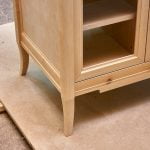Are you interested in learning how to start making money woodworking? Woodworking can be a very profitable and rewarding venture for those who have a passion for creating beautiful and functional products from wood.
In this article, we will guide you through the process of turning your woodworking hobby into a successful business. From understanding the demand for woodworking products to mastering techniques and marketing your creations, we will provide you with valuable insights and practical tips to help you get started on your journey towards making money through woodworking.
Woodworking products are in high demand, with many consumers seeking unique, handcrafted items to decorate their homes or give as gifts. Understanding this demand is crucial for anyone looking to start a woodworking business. By offering quality, one-of-a-kind pieces, you can tap into this market and create a lucrative source of income.
In the following sections, we will cover everything you need to know about starting a woodworking business, from choosing the right projects to sell and setting up your workshop to building a brand and marketing your products effectively. Whether you are just starting out or looking to take your woodworking hobby to the next level, this article will provide you with valuable information on how to succeed in the world of woodworking entrepreneurship.
Choosing the Right Woodworking Projects to Sell
One way to determine which woodworking projects to focus on is by conducting market research. Look for popular items that are in high demand, such as custom furniture pieces, home décor, and personalized gifts. Additionally, consider your own interests and expertise in specific types of woodworking projects. For example, if you enjoy creating small wooden crafts, you may want to specialize in producing and selling these items.
In addition to identifying popular woodworking projects, it’s also important to consider the materials needed and the cost involved in creating each item. This will help you determine which products have the highest profit potential based on their selling price and production costs. By carefully selecting the right woodworking projects to sell, you can increase your chances of profitability while doing what you love.
| Woodworking Project | Profit Potential |
|---|---|
| Custom furniture pieces | High |
| Home décor | Medium |
| Personalized gifts | High |
Setting Up a Woodworking Workshop
Choosing the Right Tools
When setting up your woodworking workshop, it’s important to invest in high-quality tools that will allow you to produce professional-grade products. Basic hand tools such as chisels, saws, planes, and measuring tools are essential, but you’ll also need power tools such as a table saw, band saw, drill press, and router. Consider purchasing used tools to save money without sacrificing quality.
Designing Your Workspace
Designing an efficient workspace is key to maximizing productivity in your woodworking workshop. Organize your tools and materials in a way that makes them easily accessible while keeping the workspace clutter-free. Ensure you have adequate lighting and ventilation to facilitate comfortable and safe working conditions.
Ensuring Safety Measures
Woodworking can be a hazardous activity if proper safety measures are not followed. Invest in safety equipment such as eye protection, ear protection, and dust masks. Familiarize yourself with the safe operation of all your tools and machinery, and always follow best practices for using them. Additionally, ensure that your workshop is equipped with fire extinguishers and first aid kits in case of emergencies.
By understanding how to start making money woodworking through setting up a well-equipped and safe workshop environment, you can lay the foundation for a successful woodworking business. These initial steps are crucial for creating high-quality products efficiently and safely.
Mastering Woodworking Techniques
Woodworking is a skill that takes time and patience to master, but with the right tips and guidance, beginners can start making money from their craft sooner rather than later. One of the first steps in learning how to start making money woodworking is to become proficient in various woodworking techniques. Whether it’s joinery, carving, or finishing, honing these skills will not only improve the quality of your products but also increase your efficiency as a woodworker.
For beginners looking to master woodworking techniques, it’s essential to start with the basics and gradually work your way up to more complex projects. Taking the time to practice fundamental skills such as measuring, cutting, and sanding will lay a solid foundation for more advanced woodworking endeavors. Additionally, seeking out reputable resources such as books, online tutorials, and woodworking classes can provide valuable insights and instruction on proper techniques.
Another important aspect of mastering woodworking techniques as a beginner is understanding the properties of different types of wood. Each wood species has its own unique characteristics and requires specific handling and treatment. By familiarizing oneself with these distinctions, woodworkers can optimize their craft and produce high-quality products that stand out in the market.
In order to succeed in the woodworking business, continuous learning and improvement are crucial. Aspiring woodworkers should also take advantage of networking opportunities within the woodworking community to learn from experienced professionals and gain industry insights on refining their craft.
| Woodworking Techniques | Tips for Beginners |
|---|---|
| Start with the basics | Practicing fundamental skills such as measuring, cutting, and sanding lays a solid foundation. |
| Seek reputable resources | Books, online tutorials, and woodworking classes provide valuable insights on proper techniques. |
| Understand different wood properties | Familiarize oneself with the characteristics of different wood species for optimal handling. |
Building a Brand and Marketing Your Woodworking Business
Creating a Unique Brand Identity
One of the first steps in building a successful woodworking business is creating a unique brand identity that sets your products apart from others in the market. This includes developing a memorable logo, choosing a consistent color scheme, and establishing a distinct design aesthetic for your products. Your brand should reflect the quality and craftsmanship of your work, as well as your personal style as a woodworker.
Utilizing Online Platforms
In today’s digital age, having a strong online presence is essential for reaching potential customers. Utilize social media platforms such as Instagram, Facebook, and Pinterest to showcase your woodworking projects and connect with an audience. You can also consider selling your products on e-commerce websites such as Etsy or setting up your own online store to reach customers beyond your local area.
Networking and Collaborations
Networking with other artisans, interior designers, and local businesses can also help you promote your woodworking products. Building relationships with potential collaborators or retailers can open up new opportunities for selling your products or even creating custom pieces for specific clients. Consider attending craft fairs, art shows, or local markets to showcase your work and connect with potential customers.
By implementing these branding and marketing strategies, you can increase the visibility of your woodworking business and attract more customers who appreciate the value of handcrafted wood products.
Pricing Your Woodworking Products for Profit
When it comes to turning your woodworking hobby into a profitable business, pricing your products is a crucial step. You want to make sure that you are not only covering the cost of materials and labor but also making a profit. Here are some tips on how to price your woodworking products for profit:
1. Calculate the Cost of Materials: Make a list of all the materials used in creating a specific woodworking product, including wood, screws, glue, finish, and any other supplies. In addition to the direct material costs, be sure to consider indirect costs such as shipping and packaging.
2. Factor in Labor Costs: Estimate how much time it takes to create each woodworking product and determine an hourly rate for your labor. This will help you calculate the labor cost for each item.
3. Consider Overhead Expenses: Don’t forget to include overhead expenses such as rent for your workshop space, utilities, tools, equipment maintenance, and any other business-related costs.
4. Research the Market: Look at similar woodworking products being sold by other artisans and businesses to get an idea of what the market will bear. Consider factors such as quality, design, and uniqueness when comparing prices.
5. Set Your Profit Margin: Once you have calculated all the costs associated with producing your woodworking products, determine how much profit you want to make on each item. This will vary depending on your business goals and competition in the market.
By following these steps and considering all costs involved in producing your woodworking products, you can ensure that you are pricing them for profit while remaining competitive in the market. Remember that pricing is not set in stone – it’s important to regularly review and adjust your prices based on changes in costs or market demand.
Selling Your Woodworking Products Online and Offline
When it comes to making money with woodworking, one of the key steps is selling your products. There are various options for selling your woodworking items, both online and offline. One effective way to start selling your products is by setting up an online store.
You can use platforms such as Etsy, Amazon Handmade, or even create your own website to showcase and sell your woodworking pieces. Creating an online presence allows you to reach a wider audience and increase the potential for sales.
In addition to selling online, you can also explore opportunities to sell your woodworking products offline. This could include setting up a booth at local craft fairs or markets, as well as approaching local brick-and-mortar stores that may be interested in carrying your items. Selling offline allows you to engage with customers directly and can also provide valuable feedback on your products.
When considering how to start making money woodworking through selling, it’s important to have a clear understanding of who your target audience is. Knowing your ideal customer will help you tailor your marketing efforts and product offerings to better meet their needs and preferences. Additionally, building a strong brand identity that resonates with your target market can help set you apart from competitors and establish a loyal customer base.
Overall, finding success in selling your woodworking products both online and offline requires a combination of effective marketing strategies, understanding your target audience, and providing high-quality products that customers are eager to buy. By leveraging the power of e-commerce platforms while also exploring traditional retail opportunities, you can maximize the potential for turning your passion for woodworking into a profitable business venture.
Managing Finances and Legal Considerations for a Woodworking Business
When starting a woodworking business, it’s important to consider the financial and legal aspects in order to ensure the success and sustainability of your venture. One of the first things you need to do is set up a budget for your business.
This should include the cost of tools, materials, workspace rent (if applicable), marketing expenses, and any other overhead costs. By having a clear understanding of your financial needs, you can make informed decisions about pricing your products and setting revenue goals.
Additionally, it’s crucial to understand the legal considerations for running a woodworking business. This includes registering your business with the appropriate local and state authorities, obtaining any necessary permits or licenses, and ensuring that you comply with all zoning and building code regulations. Depending on the scale of your operation, you may also need to look into getting liability insurance to protect yourself in case of accidents or property damage.
Remember that as a business owner, you will also have tax obligations. It’s important to keep accurate records of your income and expenses so that you can file taxes correctly and take advantage of any deductions or credits available to small businesses.
Consider consulting with an accountant or tax professional who has experience working with entrepreneurs in the woodworking industry. Understanding these financial and legal aspects is crucial when learning how to start making money woodworking while maintaining compliance with legal requirements.
Conclusion
In conclusion, starting a woodworking business can be a rewarding venture for those who are passionate about working with wood. With the right strategies and dedication, it is possible to turn this hobby into a profitable source of income. Understanding the demand for woodworking products is essential, as it will help you identify which items are more likely to sell in the market.
When choosing woodworking projects to sell, consider your target audience and their preferences. Whether it’s furniture, home decor, or custom-made items, select projects that align with your skills and interests while also meeting consumer demands.
Setting up a woodworking workshop requires careful planning and investment in tools, workspace, and safety measures. It’s important to prioritize safety at all times and invest in high-quality equipment to ensure the success of your business. Additionally, mastering woodworking techniques and building a strong brand presence through effective marketing strategies will further contribute to the success of your woodworking business.
In summary, turning your passion for woodworking into a profitable business requires taking calculated steps and making informed decisions. By following the tips outlined in this guide on how to start making money woodworking, you can embark on an exciting journey towards establishing a successful woodworking business. With determination and perseverance, you can create beautiful woodwork pieces that not only showcase your craftsmanship but also bring in sustainable profits.
Frequently Asked Questions
Is Woodworking a Good Way to Make Money?
Woodworking can be a good way to make money, but it requires skill, dedication, and business acumen. Many woodworkers sell their products online, at craft shows, or through local retailers to generate income.
What Type of Woodworking Makes the Most Money?
The type of woodworking that typically makes the most money is custom or specialty woodworking. This might include creating custom furniture pieces, intricate wood carvings, or personalized wooden items. These unique, high-quality pieces often command a higher price and attract discerning customers.
Can You Make a Living Off Woodworking?
It is possible to make a living off woodworking, but it requires passion and hard work. Success in this field often involves diversifying revenue streams by selling products, teaching woodworking classes, offering carpentry services, or even writing about woodworking as a subject matter expert.
Building a sustainable business may take time and effort, but many woodworkers find it to be a rewarding and fulfilling career choice.

Hi everyone! I’m a woodworker and blogger, and this is my woodworking blog. In my blog, I share tips and tricks for woodworkers of all skill levels, as well as project ideas that you can try yourself.





